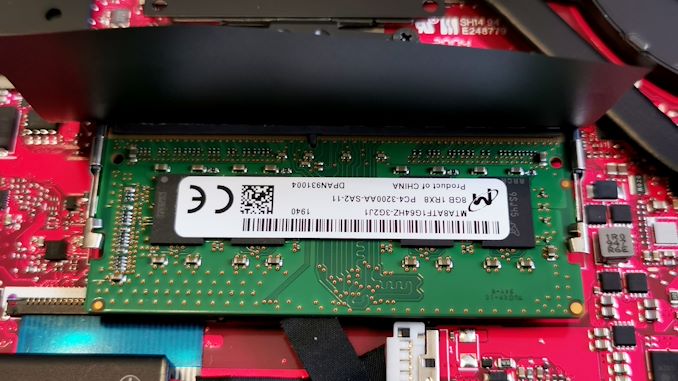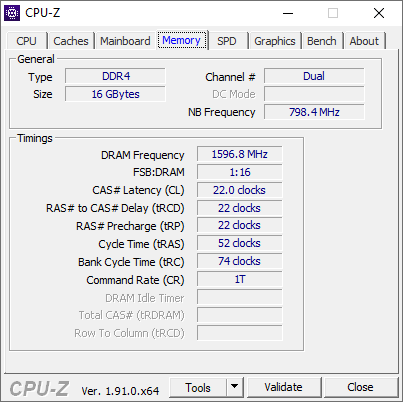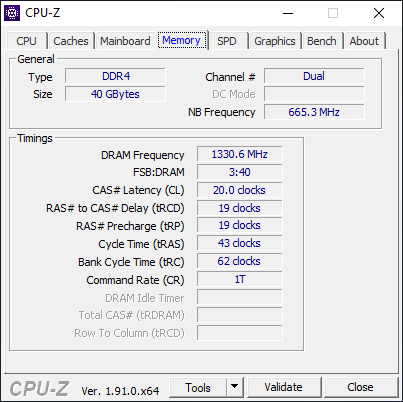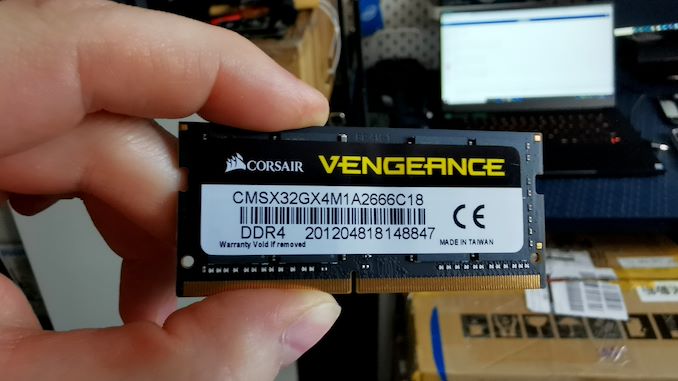AMD’s Mobile Revival: Redefining the Notebook Business with the Ryzen 9 4900HS (A Review)
by Dr. Ian Cutress on April 9, 2020 9:00 AM ESTRyzen 9 4900HS with DDR4-2666 and DDR4-3000
In our ASUS Zephyrus G14, we have a total of 16 GB of DDR4. This is split between a single SO-DIMM module of 8 GB, and a set of 8 GB memory soldered onto the board. AMD will offer a version with 16 / 16, however this might come at a later date.
This memory is running at the AMD recommended for these processors, DDR4-3200. Through our inspection tools, we can tell that this memory is running with subtimings of 22-22-22 with a command rate of 1T. The command rate is certainly good, however the 22-22-22 is a little slower than what we see on a desktop system running at this speed, because here we have a system that conforms to JEDEC’s subtiming requirements.
For our memory testing we wanted to see what speeds and capacities we could achieve. Corsair very kindly sent us some modules of 16 GB DDR4-3000 and a module of 32 GB DDR4-2666. This would give our system either 24 GB or 40 GB total respectively, which for a machine designed to do heavier duty workloads, having >16 GB is certainly welcome, as long as the performance hit isn’t too much.
I installed the 32 GB module, and the system booted first time with no fuss. A quick look to see if all the capacity was seen, and we had a total of 40 GB. The speed was also as expected, at DDR4-2666 but with subtimings of 20-19-19 1T.
However, when we put in the module of 16 GB DDR4-3000, to get a total of 24 GB, the detected speed inside the system was only DDR4-2666. Looking at the module settings, this was because the DDR4-3000 speed was actually an XMP profile, and ASUS has not enabled the ability to set XMP profiles here.
We were able to get DDR4-2666 on the 32 GB module because this is the base frequency and settings for the module. The same with the 8 GB module that came with the system – it was flashed so that the basic SPD setting was DDR4-3200. If users want to get high capacity modules with the faster DRAM speeds on this system, they will have to configure the primary SPD profile of their modules, which isn’t an easy thing to do.
As a result, our tests are going to come down to the 8 GB DDR4-3200 module that came with the system, and compare it to the 32 GB DDR4-2666 module. Note that the latter is an 8+32 configuration, which is expected to run in dual channel for the first 16 GB, and then single channel for the next 24 GB.



With our AI test, there’s a ~20% benefit from having the faster memory, which decreases slightly when moved to a limited power budget.

We didn’t see any difference in something like Cinebench.

There was more of a difference in PCMark 10, however PCM10 isn't that great in showing where the bottlenecks are.
Integrated Graphics Tests


For the Civ 6 graphics test, the difference in performance between the two memory settings is really significant. This sort of game cares less about FPS, however going down to 22 FPS for 1080p Max and No MSAA means that the user probably has to dial that back a bit to get something more reasonable.


Going from plugged in to not plugged in, we didn’t see much of a change with the slower memory, however the DDR4-3200 setting still gets a serious benefit over the DDR4-2666 arrangement.

For Final Fantasy, there a significant change - moving up from DDR4-2666 to DDR4-3200 affords a +30% improvement.
Discrete Graphics Tests




In each case, the faster DRAM actually improves discrete graphics performance.
Quick Thoughts
Overall, 16 GB of memory in a system like this isn't the best configuration - people who need the power are going to likely want 32 GB. However, users putting in their own fast module when buying the 16 GB version are going to have to be careful about the performance. Both the integrated graphics and the discrete graphics take a knock on performance going down from DDR4-3200 to DDR4-2666.















267 Comments
View All Comments
Deicidium369 - Sunday, April 12, 2020 - link
Thing is AMD is not their largest customer - they also build for Apple and Nvidia - so NO, TSMC could NOT deliver the same volume as Intel - not even close.Qasar - Sunday, April 12, 2020 - link
and intel cant deliver 10nm in volume, point is ?Namisecond - Monday, April 13, 2020 - link
Until we know actual numbers, Intel's "Can't deliver in volume" may still be more than the volume AMD can. To the point where they win the OEM contracts.Qasar - Monday, April 13, 2020 - link
and i STILL cant buy any 10nm based chips from intel, that kinda points to cant deliver in volume to me. some markets are getting them, but my local computer stores, best buy, or other stores that sell notebooks, dont have any.Deicidium369 - Monday, April 13, 2020 - link
I bought 2 Dell 2-in-1s back in October - both 10nm Ice Lake, both i7-1065G7s. The fact you can't seem to locate them at the Goodwill where you shop, doesn't change the fact they are around, and no problem to get.try http://www.dell.com
Qasar - Monday, April 13, 2020 - link
and yet more insults.. that all you got now ?? grow upDeicidium369 - Monday, April 13, 2020 - link
I would bet you that Intel has sold more 10nm than AMD has sold period. The idea that Intel can't deliver silicon is a cute story. Intel 10nm is in like 20 different designs, and there are other 10nm products other than the laptops stuff. So they are delivering it in volume - for close to a year now - and they signaled that by making the Cooper Lake 4 and 8 socket only and only having 10nm Xeon in 1 and 2 socket.Qasar - Monday, April 13, 2020 - link
" I would bet you that Intel has sold more 10nm than AMD has sold period " yea right, prove it.. most some links instead of your intel biased BSagain.. just be cause YOU were able to by intels 10nm stuff where YOU are, doesnt make it high volume, and to quote dell as being a source, good one, guess what dell as used intel for MOST of the time its been in business, and there for, more then likely gets first dibs.
Namisecond - Monday, April 13, 2020 - link
If TSMC were exclusively working on AMD stuff, possibly, but TSMC has more steady and more lucrative customers like Nvidia, Qualcomm and Apple. To make matters worse, AMD is also tying up valuable fab time with their console SoCs.Namisecond - Monday, April 13, 2020 - link
World's largest fab or not, You can't just throw some money at TSMC and demand more wafers overnight. Last I checked, TSMC was at capacity and was not accepting new orders for anything less than 18 months into the future. This is how contract suppliers work. AMD also has the problem of game console SoCs tying up their available fab capacity at TSMC. Intel owns their own fabs. If they can get their shit sorted out, they won't have capacity problems like this. Just because Gondalf makes bad fanboi arguments doesn't mean you have to lower yourself to his level.